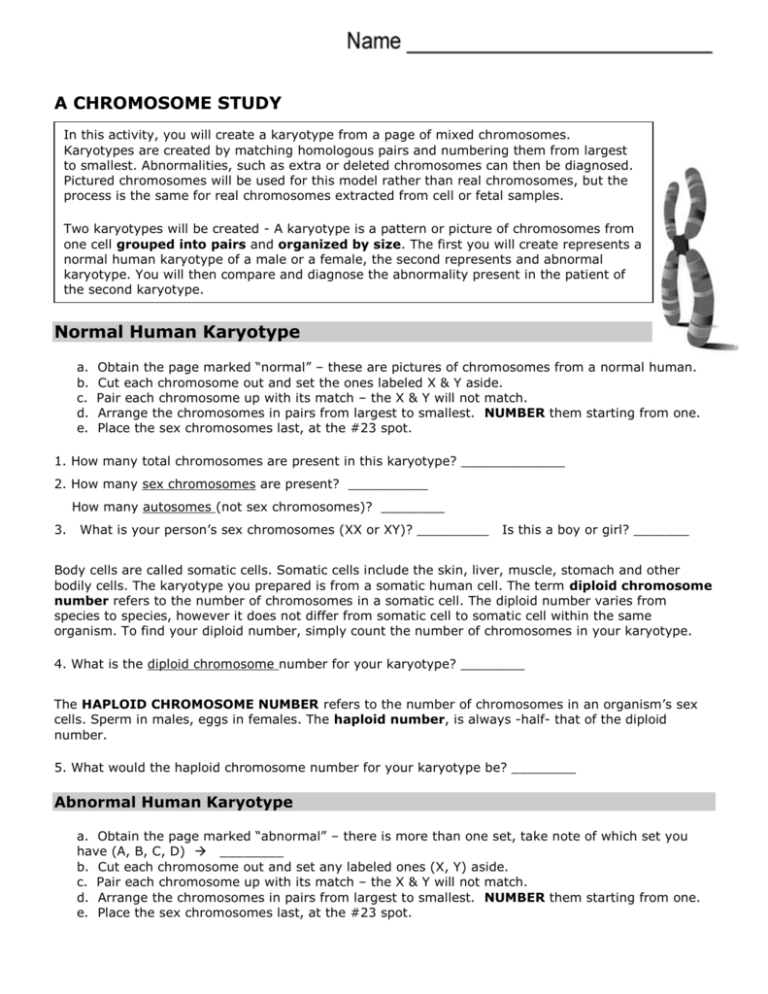A Chromosome Study - The Biology Corner
advertisement

A CHROMOSOME STUDY In this activity, you will create a karyotype from a page of mixed chromosomes. Karyotypes are created by matching homologous pairs and numbering them from largest to smallest. Abnormalities, such as extra or deleted chromosomes can then be diagnosed. Pictured chromosomes will be used for this model rather than real chromosomes, but the process is the same for real chromosomes extracted from cell or fetal samples. Two karyotypes will be created - A karyotype is a pattern or picture of chromosomes from one cell grouped into pairs and organized by size. The first you will create represents a normal human karyotype of a male or a female, the second represents and abnormal karyotype. You will then compare and diagnose the abnormality present in the patient of the second karyotype. Normal Human Karyotype a. b. c. d. e. Obtain the page marked “normal” – these are pictures of chromosomes from a normal human. Cut each chromosome out and set the ones labeled X & Y aside. Pair each chromosome up with its match – the X & Y will not match. Arrange the chromosomes in pairs from largest to smallest. NUMBER them starting from one. Place the sex chromosomes last, at the #23 spot. 1. How many total chromosomes are present in this karyotype? _____________ 2. How many sex chromosomes are present? __________ How many autosomes (not sex chromosomes)? ________ 3. What is your person’s sex chromosomes (XX or XY)? _________ Is this a boy or girl? _______ Body cells are called somatic cells. Somatic cells include the skin, liver, muscle, stomach and other bodily cells. The karyotype you prepared is from a somatic human cell. The term diploid chromosome number refers to the number of chromosomes in a somatic cell. The diploid number varies from species to species, however it does not differ from somatic cell to somatic cell within the same organism. To find your diploid number, simply count the number of chromosomes in your karyotype. 4. What is the diploid chromosome number for your karyotype? ________ The HAPLOID CHROMOSOME NUMBER refers to the number of chromosomes in an organism’s sex cells. Sperm in males, eggs in females. The haploid number, is always -half- that of the diploid number. 5. What would the haploid chromosome number for your karyotype be? ________ Abnormal Human Karyotype a. Obtain the page marked “abnormal” – there is more than one set, take note of which set you have (A, B, C, D) ________ b. Cut each chromosome out and set any labeled ones (X, Y) aside. c. Pair each chromosome up with its match – the X & Y will not match. d. Arrange the chromosomes in pairs from largest to smallest. NUMBER them starting from one. e. Place the sex chromosomes last, at the #23 spot. Possible abnormalities Disorder Patau Syndrome Edward syndrome Chromosomes Extra #13 Extra #18 Symptoms Severe deformities, death Mental retardation, heart defect Down Syndrome Turner’s Syndrome Klinefelter’s Syndrome Extra #21 Missing X (XO), female Extra X (XXY), male Mental retardation, heart defect Short stature, sterility Lack of facial hair, sterility 6. How many total chromosomes are present in the abnormal karyotype: ________ 7. Which chromosome pair is abnormal? __________ 8. What syndrome does this unborn have? (see chart) ______________________________ 9. What sex will the unborn child be? _____ Analysis: 10. Define the following terms: Karyotype _________________________________________________________________ Autosome __________________________________________________________________ Diploid ____________________________________________________________________ Haploid ____________________________________________________________________ 11. Describe two types of information that can be gained about a child before it is born through a karyotype. _______________________________________________________________________







